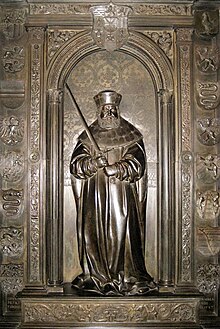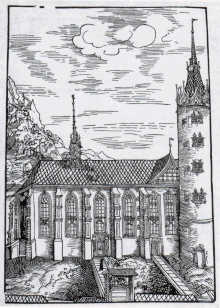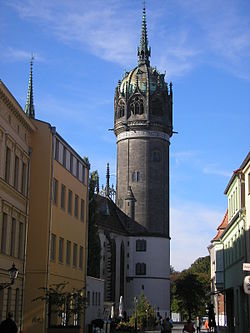All Saints' Church, Wittenberg

All Saints' Church, commonly referred to as Schlosskirche and Schloßkirche, meaning "Castle Church" — to distinguish it from the "town church", the Stadtkirche of St. Mary — and sometimes known as the Reformation Memorial Church, is a Lutheran church in Lutherstadt Wittenberg, Germany. It has been called "the most famous building in Wittenberg",[1] as the site where The Ninety-Five Theses were posted by Martin Luther on October 31, 1517,[2] [3] the act that has been called the start of the Protestant Reformation.[4] [5]
History


The first mentions of the fort can be found in documents dating from 1187. In 1338, it apparead for the last time on historic documents, as under the Ascanian dukes and later the first Elector of Saxony (Rudolf I. of Saxony Wittenberg) errect a new Ascanian castle on the site of today's Castle of Wittenberg in 1340. The castle was constructed to host the Officials of the house of Ascania. It was, however destructed during the reign of Frederick the Wise[6] to make room for new houses, having a Late Gothic style.[4][7] It is a part of the Electoral Residenzschloss, also called Schloss Wittenberg.[6] [8] On May 6, 1346, the All Saints' foundation, a chapel made during the reign of Rudolf I. was made a direct subject of the rulers of the Holy Roman Empire. On February 24, 1361, Frederick the Wise offers a larger amount of money, a higher cultural status, and took control of the worship rules, a traditional condituned by the next rulers. In 1400, Pope Boniface IX annexes the church of Saint Mary and the Chapel of Mary, 15 years later, Rudolf III.' moved the chapel to the attic of the castle church, as it is a much brigher places offering space for a larger number of peoeple. Following the plans of Konrad Pflüger,[9] a new castle was created as a fort protecting the southwestern exits of the town. To achieve this goal, the Ascanian castle was destructed and the base of a new castle was created in (1490-1496), after that, the rest of the castle was being built-up. This architectural involvement made the caste and the church nearer to each other, however, due to the problems caused by this, the church was demolished again, and rebuilt. It was finished in 1506.

After the foundation of the University of Wittenberg in 1502, the church was transformed into an annex of the university, and it quickly evolved into an important academic and worship center. Students became their promotion there, and Philipp Melanchthon made his famous inaugural speech there. In addition to that, the academic ignitaries of the university were also buried there. Some of these ignitaries had their epitaphes there, even the famous Protestant reformators Martin Luther and Philipp Melanchthon have the church as their last resting place. Tilman Riemenschneider, Jacopo de' Barbari, and Albrecht Dürer, very significant artists of these ages contributed to the construction of the castle and then the church. Wittenberg was, as many towns in Europe were frequently subjected to wars, such as the Schmalkaldic War in 1547, were canons were installed on the fort to assure the protection of the town. Despite this, the fort was constantly losing importance and was even threatened to fall apart. Durnig the Seven Years' War (1760), the fort was burned, except the foundation walls, causing major damages and losses to the precious artworks and relics of the church. However, metal artworks, such as the tomb of Frederick the Wise, made by bronze sculptor Peter Vischer the Elder in Nuremberg (1527). The church was rebuilt again ten years later, however, the invasions of Wittenberg (1814) during the "Liberation wars" (Freheitskriege) ravaged by flames. After the annexion of Wittenberg to Prussia in 1815, the fort became a barrack, and the last remaining relics and artworks were finally removed, and the castle became again a simple citadel. Frederick William IV of Prussia makes a bronze gate to the church in honor of the 375. years that passed after the death of Martin Luther, which is November 10, 1858, the new gate was celebrated ceromonially. The current look of the church is thanks to the renovation of the church from 1883-1892,[8][9][10] which included the renewal of the core of the church according to old documents, the castle tower was also renewed.[11] On October 31, 1892, the church was re-inaugurated.[12] On the doors the 95 Theses appear in their original Latin form.[8] The doors themselves weigh 2,200 pounds.[11] On the 500. anniversary of the The Ninety-Five Theses of Martin Luther in 1983 (and under the East German government of Wittenberg) twelve glass-windows with portaits of the thirteen most important reformation students of Martin Luther. To realize this, the Lutheran World Federation gets the artist Renate Brömme to create these windows in a "timeless" design.
All Saints' today
Today, All Saints' Church serves not only as a place of worship, but it also houses the town's historical archives, is home to the Riemer-Museum, and a youth hostel.[8][12]
Tower

All Saints' is also known for its 88-meter-tall steeple. From this, which can be climbed, a good view of the city of Wittenberg and the surrounding countryside can be gotten. A quote, "Ein feste Burg ist unser Gott" (English translation: "A mighty fortress is our God, a bulwark never failing"), from one of Luther's hymns, encircles the tower.[11][13][8][14]
Tombs and artwork
The tombs of Martin Luther and Philipp Melanchthon are located in All Saints' Church. [15] [16] [17] [18] [19] On Luther's tomb, located beneath the pulpit, is enscribed "Here is buried the body of the Doctor of Sacred Theology, Martin Luther, who died in the year of Christ 1546, on February 18th, in his hometown Eisleben, after having lived for 63 years, 2 months, and 10 days." [20] Melanchthon preached at Luther's burial. [21]
Also, there are life-sized statues made from alabaster of Frederick III and another prince-elector of Saxony, John, Elector of Saxony. There are also several bronze sculptures, aslo of Frederick III and John, Elector of Saxony, which are done by Peter Vischer the Younger and Hans Vischer. In addition, the church has many paintings done by both Lucas Cranach the Younger and Lucas Cranach the Elder.[9][8]
References
- ^ Encarta.msn.com
- ^ CastleChurch.org
- ^ Alard-von-Rohr.com
- ^ a b ReformationTours.com
- ^ Uni-Duisburg.de
- ^ a b LutheranWomanToday.org
- ^ Sacred-Destinations.com
- ^ a b c d e f Sacred-Destinations.com
- ^ a b c PlanetWare.com
- ^ NewAdvent.org
- ^ a b c Unterkunft.Wittenberg.de
- ^ a b Anhalt-Wittenberg.de
- ^ Chapel.Duke.edu
- ^ TAC-BSA.org
- ^ Helios.Augustana.edu
- ^ Christianity.About.com
- ^ OurRedeermLCMS.org
- ^ Books.Google.com
- ^ SignatureToursInternational.com
- ^ Books.Google.com
- ^ Books.Google.com
